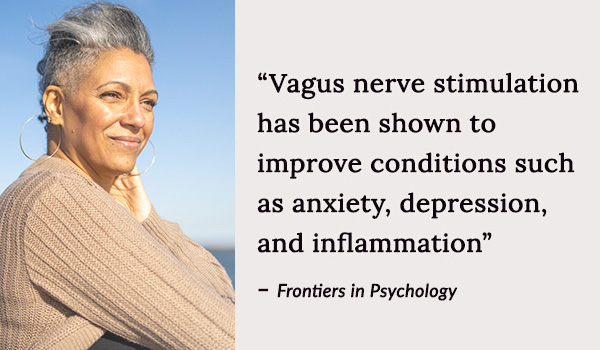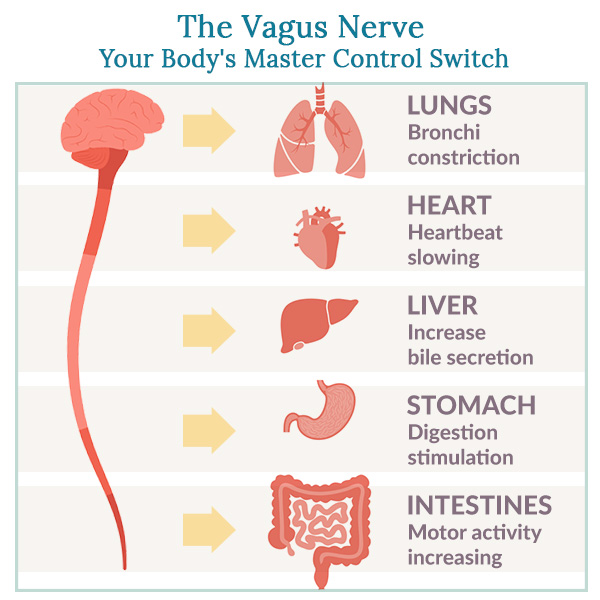Authored by Dr. Sharon Stills, NMD

If you could use some help restoring your emotional resilience, here are some surprisingly easy techniques for bouncing back.
How to boost your emotional resilience
When people are under chronic stress, the body’s fight-or-flight response becomes constantly engaged, sending cortisol levels higher and triggering the body’s sympathetic nervous system — that part of the nervous system that responds to stress with rapid and shallow breathing, constricted blood vessels and increased heart rate.
For instance, if you often find yourself in an antsy, agitated mood with that heart-racing-jumping-out-your-skin feeling, there’s a good chance that excess stress has you “stuck” in your sympathetic nervous system.
To get unstuck, you need to give your body support to activate its parasympathetic nervous system. This is the part of the nervous system that boosts emotional resilience by helping the body recover and heal from stress.
1. Switch off stress by stimulating your Vagus nerve
A powerful and fast way to switch off your stress response and switch on your parasympathetic nervous system is to stimulate the body’s Vagus nerve. This nerve extends from the brain through the face and neck to the abdomen and GI tract, and is considered a miraculous nexus that maintains a kind of balancing act between your stress response (the sympathetic nervous system) and your healing response (the parasympathetic). When the Vagus nerve is activated, it shifts the balance to the parasympathetic, putting the brakes on the body’s stress reflex. As a result, blood vessels relax and widen, creating a greater sense of calm.

Try deep belly breathing
One simple way to activate the Vagus nerve is deep “belly” breathing. The rhythmic action of deep breathing stimulates the nerve endings in the abdomen.
Get started with slow abdominal breathing with just a few steps:
- Sit upright in a chair or lie on your back on a yoga mat or in bed with your knees bent and your head supported with a low pillow.
- Place one hand on your upper chest while the other rests on your belly, just below your rib cage.
- Breathe in slowly through your nose, drawing the air in deeply towards your lower belly. The hand on your chest should remain still at first, while the one on your belly should rise.
- Exhale slowly through pursed lips. The hand on your belly should move down to its original position.
- The inhale and exhale should both be relaxed, but make sure the exhale is longer than the inhale.
Practice this breathing pattern for at least 10 minutes a day. But if it’s been a high stress day, take a few extra deep breathing breaks to help you maintain calm. The relaxed state of mind you feel after deep breathing makes it that much easier to deal with everyday stressors.
2. Reset emotional resilience by taking a cold plunge
Itching to tell the irritating people in your life to “go jump in a lake?” Turns out that taking a dip is actually a great technique for lowering stress — as long as that lake you’re jumping into is cold! Researchers have found that cold exposure on a regular basis stimulates the Vagus nerve, which helps to lower sympathetic response and increase parasympathetic nervous system activity.
But you don’t really need to jump in a cold lake to get the benefits. For beginners, an easy way to experiment with cold therapy is to turn the water colder for the final 30 seconds of your morning shower, then gradually work up to taking a completely cold shower. If you live in a colder climate, try spending short periods of time outdoors wearing fewer layers of clothing so you actually feel the chill before coming back inside. (Weather permitting, of course! If it’s frostbite season where you live, bundle up.)
Cold-plunging also supports healthy immune function, improved mood, better circulation and reduced inflammation. If you need a baby step to help you ease into cold-plunging, try dipping your face in a large bowl of cold water for a few seconds at a time.
3. Chanting and ear massage
Other ways to stimulate the Vagus nerve include chanting and mediation that uses a spoken mantra — both of these practices are so good for stress relief, partly because they stimulate the Vagus nerve endings in the back of the throat that help you to enter a deep state of relaxation. Try working a 10- or 20-minute meditation time into your morning routine.
The Vagus nerve also touches the ear. You can stimulate this nerve ending placing your finger in the hollow of the “cymba conchae” (that deep curve of the outer ear) and gently rubbing the skin in a circular pattern whenever you feel stressed.
4. Put new tools in your stress relief toolbox
If your idea of stress relief involves filling a wine glass at the end of another draining day, look for different techniques that help you “get out of your head” without the need to get inebriated. Here are some ideas to try to boost your emotional resilience:
- The Japanese call the practice of walking in nature to de-stress “shinrin yoku,” or forest bathing. To forest bathe, find a local nature trail and let your head empty as you walk so that you are only focused on your five senses. What do you see, smell, touch, taste and hear? Research shows that even a short 15-minute walk in nature can ease depression and stress.
- Talk to a therapist. If you just can’t stop yourself from overreacting to stress — i.e., every mole hill has become a mountain in your life — talking to a therapist can give you more coping tools and needed perspective. Mental health care is in high demand these days. If finding a local therapist with openings is difficult, telehealth/online therapy options may offer you greater availability and flexibility.
- Volunteer. Read to children at your local library, or volunteer at a local school. Get involved at the senior center or animal shelter or volunteer at a non-profit thrift shop. With the pandemic finally over, volunteering is a great way to feel connected to your community again. As an added bonus, when you help others problem solve, you boost your ability to see solutions for stress that shows up in your own life.
5. Reframe your perspective
Catastrophic thinking is a learned cognitive bias in which our brains start to select and highlight facts that confirm a certain fear, and ignore those that contradict it. Most of us have done a lot of catastrophic thinking over the past few years and all this anxiety, worry and “doom scrolling” hasn’t helped anyone’s emotional resilience.
The next time you notice yourself dwelling on catastrophic thinking, consciously challenge these negative thoughts. When you’re “catastrophizing,” you might start out with a thought such as, “I feel bad today.” This thought may then expand to, “It’s only going to get worse,” or “I’ll never get better.”
As you notice these thoughts, step in and literally say out loud, “Stop!” or “No more!” Next, use deep breathing, positive affirmations, meditation, journaling and other stress relief techniques to help you let go of irrational fears and refocus your thoughts. I also find it effective to ask myself, will whatever is bothering me in the moment matter in 5 minutes, days, months or years? Over time these types of techniques will make it easier and easier to restore perspective.
Stop catastrophic thinking
In her book The Work, author and healer Byron Katie wrote powerfully about how this process of remaining alert to and questioning stressful thoughts changed her entire outlook on life: “I discovered that when I believed my thoughts I suffered, but when I didn’t believe them I didn’t suffer, and that this is true for every human being. Freedom is as simple as that. I found that suffering is optional. I found a joy within me that has never disappeared, not for a single moment. That joy is in everyone, always.”
All of this isn’t to diminish the very real suffering that’s happened for many. The practice of reframing your perspective is meant to help you make sure you’re not carrying an even heavier burden.
6. Support your stress response
When you are under chronic stress, the constant tripping off of the body’s fight-or-flight response can create adrenal hormone imbalances and lowered thyroid function, leading to problems with mood and stress regulation.
When thyroid function slows during stress, triiodothyronine (T3) and thyroxine (T4) hormone levels fall. As a result, if they fall low enough, you can enter into a state of hypothyroidism (low thyroid). Then you can experience symptoms of low thyroid including fatigue and depression.
When your body is struggling so much from these physiological effects of stress it’s difficult to have emotional resilience. You want to make sure that you are supporting your adrenal glands and thyroid to rebalance hormones and protect against stress symptoms. But are your adrenals and thyroid at risk? You can take our free Hormonal Imbalance Quiz to learn more about stress-related hormonal symptoms you may be experiencing.
7. Healing the trauma wound
We have collectively experienced trauma over the past few years. This wound is at the root of so much of the fear, anxiety and stress we’re experiencing. Will you join me in healing this wound? The following meditation, adapted from a Metta Institute meditation focuses on loving kindness as the ultimate healing balm — for yourself and everyone around you.
Get comfortable and allow yourself to deeply feel the intention of these words as you say each line:
Think about yourself as you say: “May I be happy. May I be well. May I be safe. May I be peaceful and at ease.”
Think about a loved one as you say: “May you be happy. May you be well. May you be safe. May you be peaceful and at ease.”
Think about someone who you don’t love and/or who troubles you as you say: “May you be happy. May you be well. May you be safe. May you be peaceful and at ease.”
Think about the whole world as you say: “May you be happy. May you be well. May you be safe. May you be peaceful and at ease.”
End your mediation with the words: Safe, happy, healthy.
Inner peace makes everything easier to deal with — even that crowded supermarket with only one register open! Get in touch with me on social media and let me know how these tips worked for you.
Be well.














